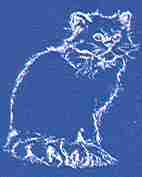| Norman Johnston & Colourpoint |  |

| Norman Johnston & Colourpoint |  |
Norman Johnston was not only a major historian of Irish locomotive history, but is also a gifted designer of railway books who had been capable of maximizing the pictorial quality of some early colour images. His colophon reproduced above would appear to indicate that he is also a cat lover. That he was a polio victim is indicated in a Backtrack article. His publications attracted excellent reviews.
Clements, Jeremy and McMahon, Michael.
Locomotives of the GSR. Newtownards: Colourpoint, 2008. 384pp.
"This work deserves to be the standard work on the steam locomotives
of Southern Ireland in the inter-wars. ... A superb work indeed!".
DWM in Backtrack, 2009,
23, 638. KPJ agrees with the general sentiment, but has a few
reservations, including one major one: the lack of an index which should
make steamindex more valuable. The lack of any line drawings is to be regretted,
especially as many must be available. Some of the sections are excellent:
notably the description of the unreliable Watson 400 class, which appeared
to make the Claughton class look highly succesful, and the excellent "Maunsell"
moguls. Both these sections reflect upon British locomotive design in general,
and make this a significant contribution to the history of British locomotive
development. It should also be noted that the section on McDonnell and his
Irish success makes his failure at Gateshead to be even more of a mystery.
The authors do not appear to be aware of the Minutes of the Association of
Railway Locomotive Engineers as prepared by Geoffrey Hughes. Morton was a
member of this select body prior to Bazin being proposed by Gresley. The
authors explain that the 101 Class receives little attention as it
has been covered in depth elsewhere. To the non-Irish reader it might have
been helpful if a little more had been included on the corporate nature of
the Great Southern Railways, and on the influence of the young State. The
damage inflicted by the Civil War and the Emergency (WW2 everywhere else
on earth) and in particular the fuel shortage are recorded, however. There
must also have been difficulties in the supply of spare parts for locomotives
from war-torn Great Britain. One locomotive was sent north to assist the
devastated BCDR.. .
Collins, Michael. Rail versus road in Ireland, 1900-2000.
Coloupoint, 2000
Cited Macnair Backtrack, 2020,
34, 315.
Johnston, Norman. Locomotives of the GNR(I).
Newtownards: Colourpoint, 1999, 208pp.
Colourpoint has become well-known as the publisher of excellently
received books, especially those containing colour photographs. The Author
was the creator of the publishing business, and this book must be its
masterpiece.
James Kilroy, Irish trams. Colour Point.
Reviewed by John Edgington in
Backtrack, 1997, 11, 632 who noted that excludes the Agrina
branch, but includes the Clogher Valley Railway.
Scott, William.
Locomotives of the LMS NCC and its predecessors. Newtownards: Colourpoint,
2008. 192pp. Bibliog.
Richly illustrated. Includes some very interesting photographs of
Royal Train used by the Duke and Duchess of York in July 1924 and by HM the
Queen and the Duke of Edinburgh in her Coronation year: the latter is reproduced
on the end papers. The Festival is also illustrated. Locomotive weight
distribution diagrams of more recent classes.
White, Ron with Norman Johnston
LNER locomotives in colour 1936-1948. Newtownards: Colourpoint,
2002.
Ron White is the creator of ColourRail, the major commercial archive
of colour transparencies relating to transport. Many of the originals for
this book came from H.M. Lane and many were taken at Wakefield Westgate.
See letter from J.T. van Riemsdijk
in BackTrack, 18, 188. Magnificent, but did nobody capture
the P2 class in colour? From a personal standpoint one of the most exciting
pictures is of a wartime freight travelling north between Potters Bar and
Brookmans Park taken from the footpath above the mainline (this was a favourite
location for KPJ in about 1941).
Observations from a hospital bed. [of
GNR (I) trains]. Norman Johnston. Backtrack, 2000, 14,
6-11.
Author was a child polio victim in 1957 and had to spend nineteen
weeks in bed at the Musgrave Park Hospital in Belfast, from which he could
see the GNR (I) trains to Dublin and a variety of lesser services. In May
he was taken by his father to Scotland where he encountered the A4 class
and was even given the treat of a journey to Newcastle and back (on the return
journey the train engine was an A4 Silver King).
2015-05-30